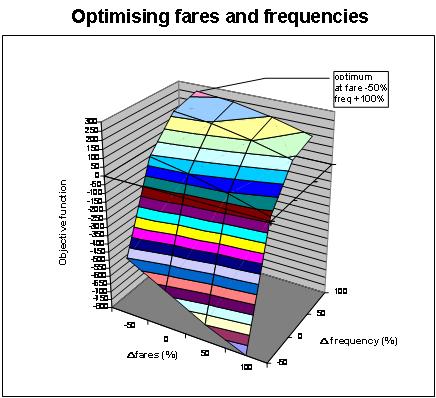| What do we mean by optimisation?
Strictly optimisation means finding the best solution to
a given set of transport problems, or the best strategy to
meet a given set of objectives. In practice, cities will not
often be free to implement the combination of policy instruments
which is theoretically best for them, either because they
do not have overall control on all policy instruments (for
the reasons given in (Section
3) or because they face barriers of finance or acceptability
(Section 10). In practice,
therefore, optimisation involves identifying the best solution
within a given set of constraints.
Why should we use optimisation methods?
Traditionally, cities and their consultants have attempted
to determine the best strategy through a process of identifying
a possible solution, testing it (Section
12 ), appraising it (Section
13) and then seeking improvements. These improvements
could either be straightforwardly to increase performance,
or to overcome barriers such as lack of finance or limited
public support. However, this process can be inefficient;
time will be wasted on testing inappropriate strategies, and
there is no guarantee that the best strategy will be found.
Thus the benefits of optimisation are both in developing more
effective strategies and in doing so more rapidly. In an early
example in Edinburgh, an initial study used some 70 model
runs to develop a “best” strategy; a subsequent
study using optimisation methods found a combination of policy
instruments, after 25 model runs, which increased economic
efficiency by a further 20%.
Optimisation is thus a very elegant way of choosing the best
strategy. Even if we do not often want to automate the decision
making process in this way, experience shows that it produces
interesting new strategies that would not otherwise have been
thought of.
How does optimisation work?
Formal optimisation is a relatively new concept in the analysis
of integrated land use and transport strategies. We describe
it further in the PROSPECTS Methodological Guidebook, and
in a more recent report on the generation of optimal strategies
for UK cities. It involves maximising a quantified objective
function within a given scenario, and subject to a given set
of targets and constraints, by using a given range of land
use and transport policy instruments.
How are objectives represented?
At the heart of this policy optimisation process lies the
definition of the objective function, which is a quantified
measure of the policy-makers’ objectives and the priorities
between them. The objective function should be consistent
with the appraisal framework (Section
13), and can thus be based on either a Cost Benefit Appraisal
or a quantified Multi-Criteria Appraisal, in which weights
are assigned to the individual objectives. The value of the
objective function for each set of instruments and their associated
levels is derived by running a land-use transport interaction
model (Section 12).
How are scenarios and constraints reflected?
Scenarios can be selected based on the principles in Section
11. Often the strategy is optimised against one scenario,
and the optimal strategy is then tested for robustness against
other scenarios. In due course methods may permit optimisation
to be pursued for all scenarios, with techniques of appraisal
under uncertainty being used to minimise the risk of poor
performance under more demanding scenarios.
Constraints can be dealt with in two ways. Political barriers
can act as a constraint on which instruments may be considered
and within which ranges; for example parking charge increases
of above a given level may be considered unacceptable. Financial
barriers and outcome targets can be incorporated within the
optimisation process; for example a restriction on capital
investment could be used to rule out those strategy options
which exceeded it. In either case the optimisation can be
repeated without the barrier to demonstrate the benefit of
removing it. This can help in making the case for changes
in legislation (Section 10).
How are policy instruments selected?
Policy instruments can be chosen from the list in Section
9. In due course, new approaches to option generation
may help to suggest which policy instruments should be considered.
A formal optimisation process is most useful in considering
a package of strategic instruments which are expected to have
a significant impact on the city. They will reflect the key
strategy elements in Section
11. Most strategic instruments have some level which may
be varied (e.g. a price) which can be optimised. The diagram
shows an optimum for a range of levels of fares and frequencies.
Some, such as discrete road and rail projects, are either
included or not. Once an optimal set of strategic instruments
has been selected, other second order elements of the strategy
(Section 11) may be added
in ways which enhance the overall policy.
When are optimisation methods appropriate?
When a city is assessing a relatively small number of policy
instruments, or simply assessing one new proposal within a
given strategy, formal optimisation is unlikely to be needed.
However, where the number of options is substantial it will
often be much quicker and less expensive to use a model in
conjunction with an optimisation method than to use the model
alone. Where there are several scenarios to consider, or constraints
whose impact needs to be assessed, optimisation can prove
even more valuable.

|




